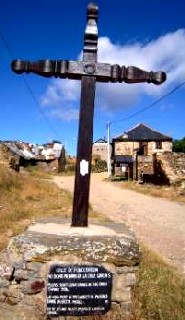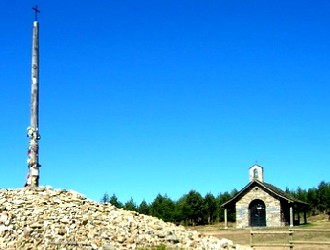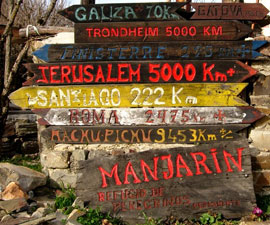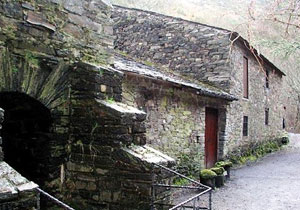Camino de Santiago - French Way - Stage 25, page 1 - Rabanal del Camino to Molinaseca
Total distance: 25 km

Walk out of Rabanal del Camino past the churches of San Jose and Santa Maria and down a country lane until you reach the road. After about 2 kilometres you come across the Fuente del Peregrino and following a continuous climb for a further 4 kilometres you come into the village of Foncebadón. Just as you are approaching the village you will see a wooden cross known locally as el Cruz de Foncebadón. It kindly asks you in 4 different languages, including English, to not leave stones on the cross. This you may ask is a little odd but you will see what we mean a little later.
Foncebadón like so many other villages has been linked directly to the fortunes of the Camino de Santiago. The village grew during the Camino's height in the 12th century even having its own pilgrim hospital, hospice and church built by the hermit Gaucelmo, the remains of which you will pass on your way out of the village. However the village very nearly disappeared altogether, at one point only having 2 inhabitants. With the resurgence of the Camino de Santiago over the last few years the village is slowly but surely coming back to life and some people who have passed through on their way to Santiago have loved it so much that they have come back and settled here. Should you wish to spend the night here you have the choice of 3 albergues.
As you leave the village you pass what remains of the church and hospital built by Gaucelmo. After a short while, approximately 1 kilometre, you come to the road again where you turn left and about 300 metres later you come to the top of Monte Irago and the Cruz de Ferro (iron cross). I mentioned just as you entered Foncebadón that the cross there asked you not to put stones on the cross, here is why.

Where the cross is now located is thought to have originally been an altar built to the Roman god Mercury, whereas some stories say that it is where the Celts worshiped, either way the origins were pagan. The cross is believed to have been placed here in the 11th century by Gaucelmo.
Traditionally pilgrims have left a rock here, whether picked up along their journey or brought all the way from their homeland. Some of the rocks that have been left here contain little messages to loved ones or the name of the pilgrim's home town. In the holy year of 1982 the little Ermita de Santiago, that you see close by, was built. There is also now a huge sundial on the floor where you provide the shadow in order to tell the time.
Thankfully from here until you reach Ponferrada the route starts to descend for the most part and after about 2 kilometres you reach the village of Manjarín.

Unlike its neighbour Foncebadón which still had a couple of inhabitants, Manjarín was completely abandoned at the beginning of the 19th century. It too relied heavily on the traffic of passing pilgrims and like so many villages we have passed through had a pilgrim hospital run by the Knight's Templar. There is only one person in the village now and that is a gentleman called Tomás Martinez who runs the small, rough and ready albergue here. He is a real character, dressing up as a Templar knight for his visitors. Just outside the albergue are a number of wooden planks showing the distances to various places, of particular interest to us is the one that lets us know there are only 222 kilometres to our final destination, Santiago.
From Manjarín you continue to follow the road for approximately 2 kilometres passing a military base up on the hill. At around this point you have reached the highest point of the entire Camino de Santiago at 1,515 metres above sea level, that's approximately 4,970 feet. The views on a clear day are spectacular. The steep downhill section starts from this point heading towards the El Bierzo valley and its former Roman gold mines. Keep on following the track until you enter the village of Acebo.
The village of Acebo has a couple of interesting pieces of history. As you have walked from Foncebadón you will have passed a number of posts. Back in the Middle Ages these numbered around 800 and it was up to the inhabitants of el Acebo to maintain them so that pilgrims would not get lost in the snow. So important was this job considered to be that the king exempted the inhabitants from paying taxes on condition that they continued to maintain those marker posts. I somehow doubt they are exempt from tax now and whether it's the villagers that maintain them.

The other piece of history does not refer specifically to el Acebo but to a small village about 5 kilometres away called Compludo. We don't pass it on the Camino but there is a detour if you wish to take it. I mention it because I thought that it had an interesting legend. In the 7th century San Fructuoso founded a monastery there and included a blacksmiths forge or herreria. What made it famous was that it was said to have been the place where the sword used by Pelayo during the Batalla de Covadonga was forged. Pelayo was the founder of the Kingdom of Asturias and was the first to have banished the Moors from his Kingdom therefore starting the Reconquista.
Continued at Stage 25 - page 2.

